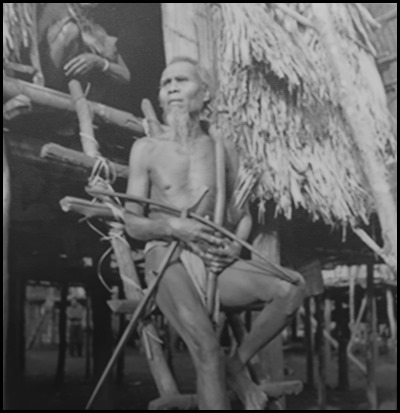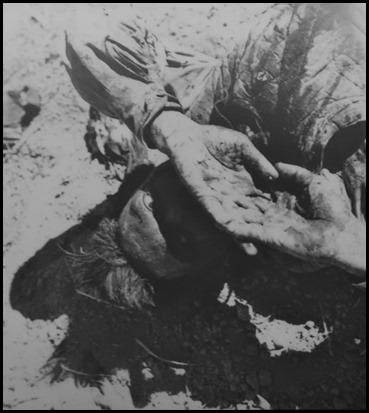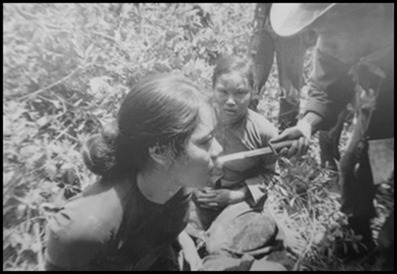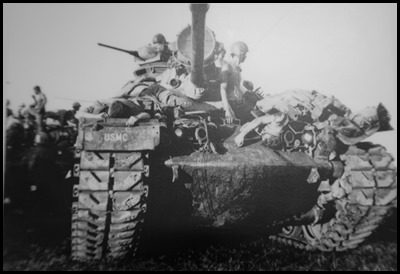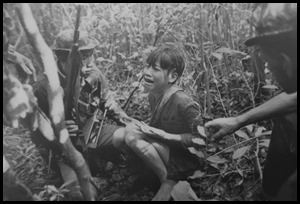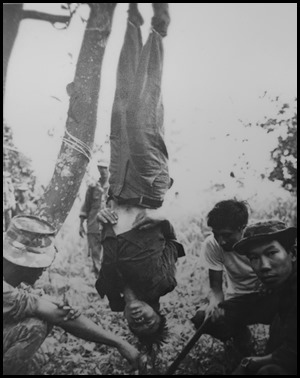War Remnant Photographers

|
War Remnant Museum – Photographers
Collection
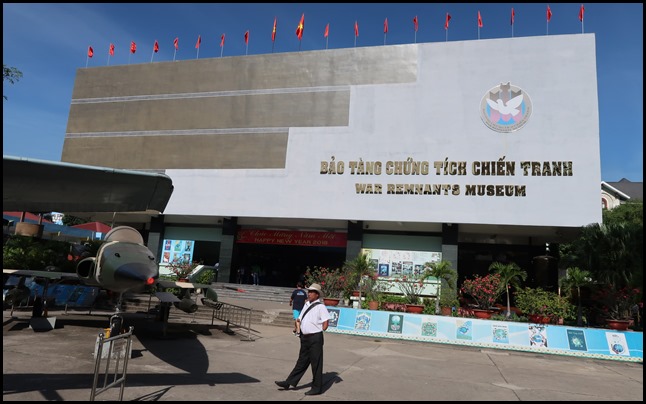 This morning we
began our Ho Chi Minh City tour at the War Remnants
Museum. The man in the picture came up to us wanting
to sell his books or gather charity, he had nothing below the elbows. Stark
start. Gritty and sickening images later in the blog, not for
some..............
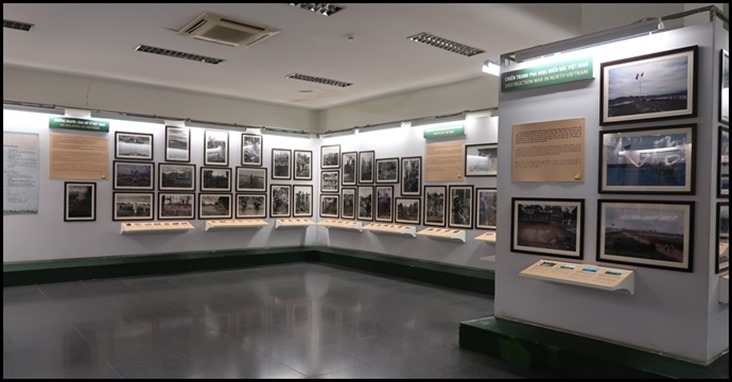 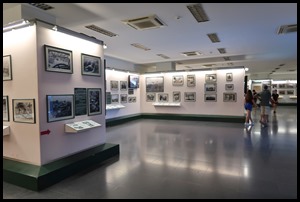 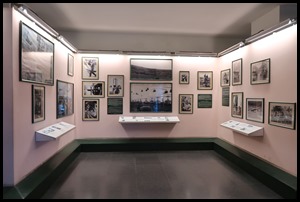 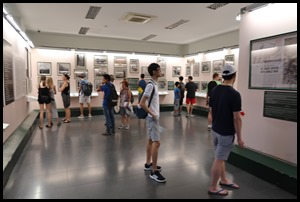 We went to the top floor of three
with the idea of working our way down, this meant we began in the Agent Orange
exhibit and photo gallery. Horrific and graphic pictures that told of human
suffering that carries on to this day. Then we moved to an exhibition of
photographers from the UK, France, USA and Viet Nam covering various events and
battles.
Man’s
inhumanity to man has been going on since the beginning of time. Every country
has events in the past not to be proud of. Things happened here in Viet
Nam (on all sides) and the photographers were just doing their
job.
We read a comment when we visited the East Wing Museum in
Hiroshima, a photographer battled with himself as to whether he should record
what was happening. Was it too personal, private, intrusive or did he
need to be there so the world would know. I stood in front of the first
picture that had caused his twenty minute hiatus, could I snap, of course I
could, and many more of his scenes just like it. Pictures are powerful not only
in War Crime Courts but visually they are far more memorable than words. Imagine
having pictures of Biblical events...... Nowadays my personal concern is image
interference. Thank heavens there was no Photoshop in the past or any of the
following.
Excerpts from the
introduction to the book ‘Requiem’ by David Halberstam, written in 1996 were
used as the introduction to the exhibition.
Introduction
The title says
that is it a requiem for a war, but as much as anything else, this is a form of
homage on the part of those who made it back from Vietnam to the memory of those
who did not. The photos evoke dual images, not just those of a terrible and
violent time and of all the casualties of that war, both civilian and military,
but images as well for many of us, of the faces of the men and women who were
there, who were our friends, and who took these very photos. We are reminded of
their bravery, of the terrible risks they took, and, of course, constantly, of
our own good fortune.
......War
correspondents always know who is real and who is not. A war zone is not a good
setting for the inauthentic of spirit and heart.
We, who were
print people, and who dealt only in words and not images, always knew that the
photographers were the brave ones, and they held in that war, which began in an
era of still photography and ended with color film and videotape beamed by
satellite to television stations all over the world, a special place in our
esteem. We deferred to them, reporter to photographer, as we did in few other
venues.
.....These photographers have given us something
special, a remarkable record of that distant war, many of their photos taken
when few people cared about what was happening there. They have given us images
that have had the power to endure long after the war was over. Now that the war
is past, consigned to the normal negligence accorded to history in America,
those images remain powerful, a critical part
of what constitutes modern memory. We are grateful to those who took the photos,
now as then, forever in their
debt.
Everette Dixie Reese, Central Highlands, Vietnam, 1950’s. The tribes people of Vietnam’s central highlands played an important role in the guerrilla warfare in Vietnam’s mountain jungles between 1946 and 1975. Jean Peraud, Tonkin, Vietnam, Dec. 01, 1952. A Vietnamese prisoner during the battle of Na San stares at his French Captors. French paratroopers were gathering Viet Minh wounded and dead following a victorious counterattack to regain control of a position lost the previous night. (SIRPA-ECPA)
Huynh
Thanh My, Mekong Delta, Vietnam, 1965. The woman had her hands tied was
submerged repeatedly as soldier interrogated her. They sought information about
the local guerrilla forces. She was later imprisoned.
Dana Stone, Con Tien, Vietnam, 1967. An U.S. tank carrying the bodies of fallen Marines moves out of Con Tien, south of the DMZ, following hand-to-hand combat with North Vietnamese troops. Tanks were sent in to recover the dead and wounded but had to withdraw under North Vietnamese counterattacks. (United Press International)
Bui Dinh Tuy, Ho Chi Minh Trail, 1966. A woman soldier of
the North Vietnamese Army carrying an ammunition crate wades through a river
along the Ho Chi Minh supply trail. The markings on the crate are in English.
(Vietnam News Agency)
Sean Flynn, Duc Phong, Vietnam, 1966. A young Viet Cong
suspect cries after hearing a rifle shot. His captors, Chinese Nung tribesman in
the service of the U.S. Special Forces, pretended to shoot his father, a ruse
designed to make the boy reveal information about Communist guerrillas. (United
Press International)
Sean
Flynn, Duc Phong, Vietnam, 1966. A Viet Cong suspect is hung up and questioned
by mercenaries of the Chinese Nung tribe. The Nungs formed a Special Forces unit
organized and commanded by U.S. Special Forces. After 15 minutes in this
position the suspect admitted being the sniper who earlier had fired on refugees
sheltered in a church. (United Press
International)
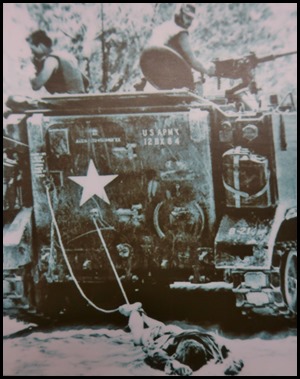 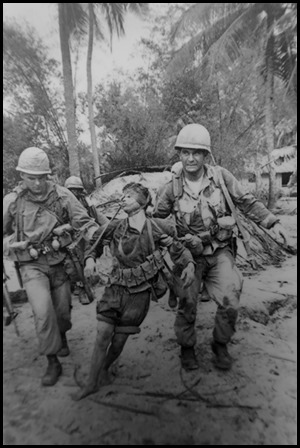 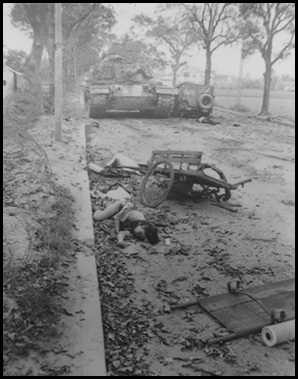 Kyoichi Sawada, Tan
Binh, Vietnam, 1966. The body of a Viet Cong soldier is dragged behind an
armoured vehicle at Tan Binh en route to a burial site after fierce fighting
February 24, 1966. (United Press
International)
Kyoichi
Sawada, Bong Son, Binh Dinh, Vietnam, 1966. An injured North Vietnamese soldier
is led from his bunker by soldiers of the U.S. First Cavalry Division. This
soldier held up the U.S. advance for one hour with machine-gun fire from his
position. He was wounded and captured. “If he was in the American army”, said
U.S. Army Colonel John Moore at the time, “I would recommend him for a medal”.
(United Press
International)
Kyoichi Sawada, Hue, Vietnam, 1968. Two Vietnamese bodies
and a crumpled cart lie in the path of a tank. Another one lies behind the
wreckage of a jeep in the military camp adjacent to the Imperial City of Hue,
during the height of the Tet offensive battle (United Press
International)
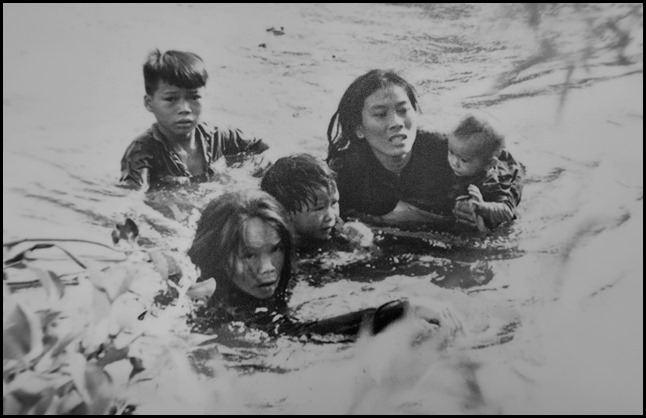 Kyoichi Sawada, Quy
Nhon, Vietnam, 1965. 1966
Pulitzer Prize-winning photograph. A Vietnamese mother and her children wade
across a river to escape bombs from the U.S. air strike. (United Press
International)
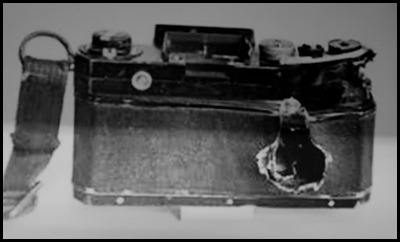 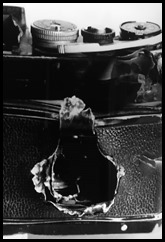
The camera of Taizo Ichinose, Kyushu, Japan, 1996. The camera
is a relic, preserved as part of a family shrine in Kyushu, Japan. Ichinose
escaped injury when he lost this camera in an ambush. (Photo by Rikio Imajo).
Some photographers were not so lucky.
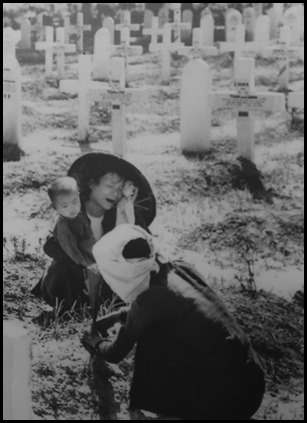  Robert Capa, last roll of film,
May 25, 1954. Military cemetery for French and Vietnamese French Union soldiers
in Nam Dinh, south of Ha Noi (Magnum Photos)
Associated Press wire photo. On
May 25, 1954 Robert Capa, photographer for LIFE Magazine, was killed when he
stepped on a land mine in the Thai Binh region of Northern
Indochina.
The Death of
Robert Capa
He said; “this is
going to be a beautiful story”
....On his delta
tour Capa had got the idea of a picture story to be entitled “Bitter Rice.” His
plan was to dramatize the contrast of tanks next to peasants working in the
paddies, of men dying in the struggle for the rice harvest.
The sun beat down
fiercely...
Capa was
exquisitely bored and climbed up on the road, saying, “I am going up the road a
little bit...” This was about 2:50 p.m.
At 2:55 the earth
shook from a heavy explosion.
...I was making
notes on this when a helmeted soldier arrived...
Without a trace
of emotion the lieutenant said, “Le photographer est mort” (“The photographer is
dead”). I understood the words but it didn’t register.
...I jumped up
and ran with the soldier down the ditch.
...At the foot of
the dike across the V formed by the bending road Capa lay on his
back...
One
camera was clutched in his left hand. I began calling his name. The second or
third time his lips moved slightly like those of a man disturbed in sleep. That
was his last movement. It was 3:10 p.m.
(John Mecklin,
Time– LIFE correspondent who accompanied Robert Capa on his last
assignment).
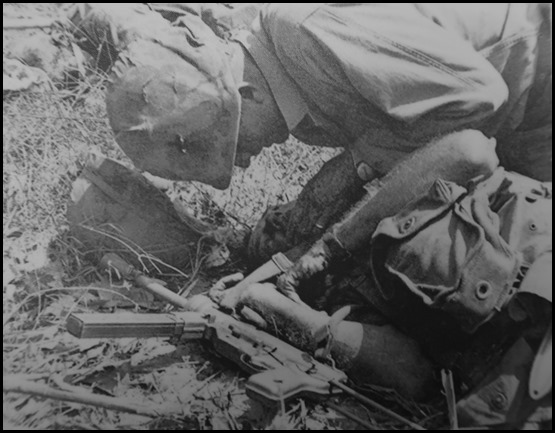 Charlie
Chellappah, Cu Chi, Vietnam, 1966. A soldier holds the face of a seriously
wounded comrade by a Viet Cong claymore mine. Charlie Chellappah stood upright
taking this picture when a second mine blast hit him and the soldiers shown.
This is his last picture. (Associated Press)
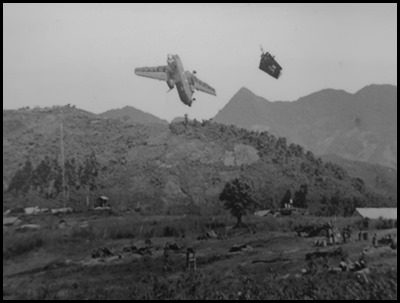 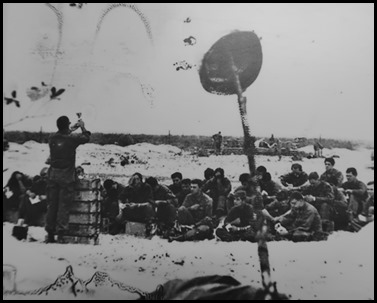 Hiromichi Mine,
Ha Phan, Vietnam, 1967. A twin-engined transport Caribou crashes after being
accidentally hit by American artillery. The ammunition-laden plane crossed a
firing zone while trying to land at the Special Forces camp in Ha Phan, near Duc
Pho, August 3, 1967. All three crewmen died in the crash. (United Press
International).
Hiromichi Mine, near Hue,
Vietnam, 1968. The fire-and-water-damaged last roll from Mine shows an army
chaplain celebrating mass for soldiers of the 1st Cavalry Division. Mine, a
Japanese photographer working for United Press International, died two days
later on March 6, 1968, when an armoured personnel carrier on which he was
riding hit a 500-pound bomb. He had severe burns. (United Press
International)
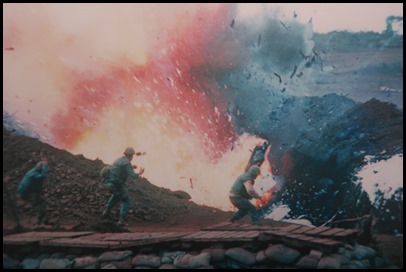  Robert J. Ellison, Khe Sanh,
Vietnam, 1968. An ammunition dump struck by a shell fired from a North
Vietnamese position explodes in front of U.S. Marines at Khe Sanh. The picture
was on the cover of Newsweek on March 18, 1968, a few days after Robert Ellison
was killed. (Black Star)
Robert J.
Ellison, Khe Sanh, Vietnam, 1968. U.S. Marines were under siege by the North
Vietnamese Army units during several months. This portrait of a Marine at Khe
Sanh was published in Newsweek after Robert Ellison was killed. (Black
Star)
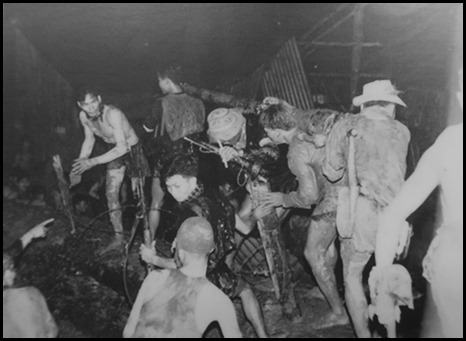 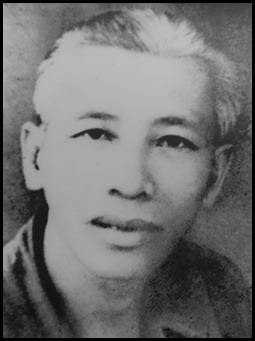 Tran Binh Khuol,
Dam Doi outpost, Ca Mau province, Vietnam, 1963. Soldiers of a regular Viet Cong
battalion mill about in a swamp as they group to attack Dam Doi outpost in the
night of September 09, 1963. Some are dragging heavy equipment. The post fell at
3:00 AM.
U Minh forest,
Vietnam, 1963. Photographer Tran Binh Khuol accompanied Viet Cong soldiers on
daring nighttime raids against South Vietnamese outposts in the Ca Mau Province.
Tran Binh Khuol was born in 1904 and became chief of the photography and
cinematography division in the communist 9th military region. He was killed in
Minh Hai (U Minh forest) 1969. (Photographer unidentified, Liberation News
Agency – VNA)
 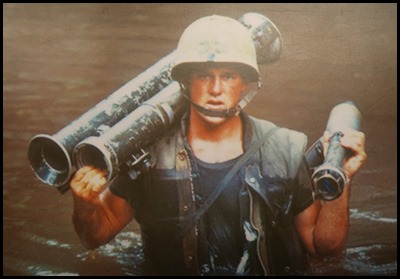 LIFE magazine
from January 25, 1963. “The vicious fighting in Vietnam” by Larry Burrows, pages 30 and
31.
Larry Burrows,
South of the DMZ, Vietnam, 1966. Marine gunner, John Wilson, shouldering a rocket launcher across a
stream, was part of a US. Marines reconnaissance force set up to counterattack
North Vietnamese infiltration just below the DMZ. He was killed in action twelve
days later. (LIFE magazine)
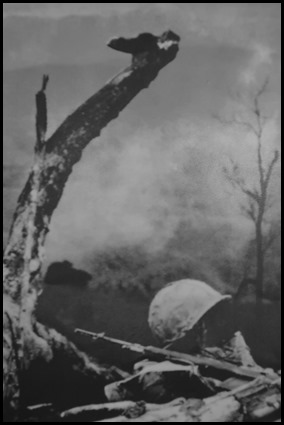 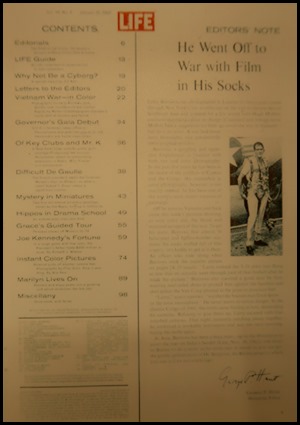 Jacket cover. The
cover photo was taken near Khe Sanh by the famous photographer Larry Burrows of
Life magazine, (Larry Burrows’
Collection)
LIFE magazine
from January 25, 1963. Page 5: Editor’s note about photographer Larry Burrows and his essay ‘The Vicious
Fighting in Vietnam’.
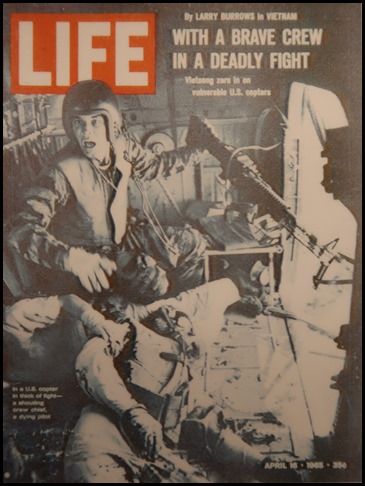 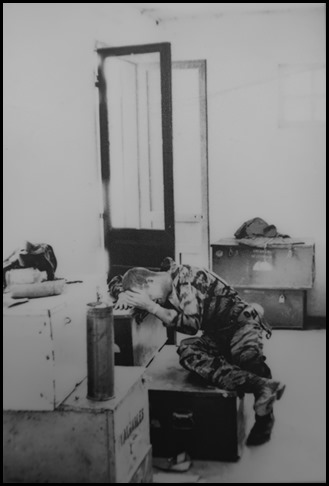 Larry Burrows,
near Da Nang, Vietnam, 1965. The cover photo of LIFE magazine from April 16,
1965: Larry Burrows’s photo essay
and story of a single bloody mission by U.S. Marine helicopter, “One ride with
Yankee Papa 13”, and of what it did to young crew chief James Farley, with his
gun jammed and with two wounded comrades aboard shouts to his gunner. is one of
the most vivid pictures narratives of any war (LIFE
magazine)
Larry Burrows,
Vietnam, 1965. “One ride with Yankee Papa 13”, In a supply shack, the tragic and
frustrating mission over, Crew Chief James Farley weeps. (LIFE
magazine)
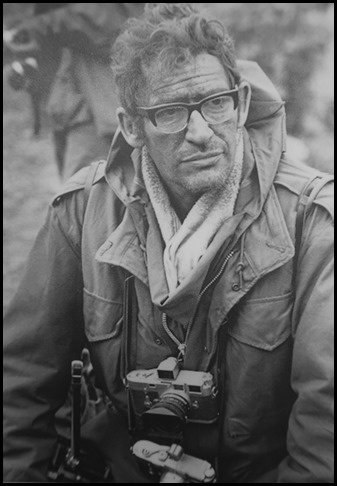 Larry Burrows at
the Laotian border, 1971. Larry
Burrows, on his last story “The Edge of Laos”, three days before his helicopter
crashed in Laos (Photo by Roger Mattingly)
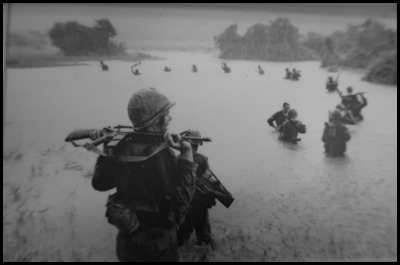 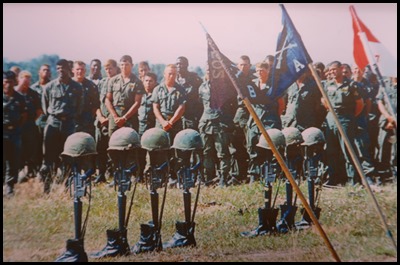 Henri Huet, War Zone C, Vietnam, 1965.
Soldiers of the U.S. 173rd Airborne Brigade hold their automatic rifles high as
they cross a river during a monsoon downpour. Their twelve-day patrol in the
jungles near Ben Cat failed to raise any contact with the Viet Cong. (Associated
Press)
Henri Huet, Lai Khe, Vietnam, 1965. A memorial
service for seven men of the U.S. 101st Airborne Brigade is held in a clearing
near a former French rubber plantation, north of Sai Gon. Their boots, helmets
and M16 rifles are set up with a field altar. (Associated
Press)
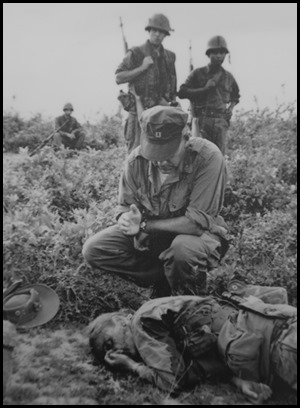 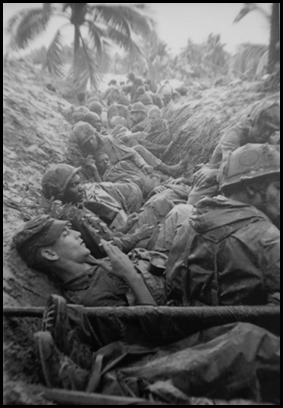 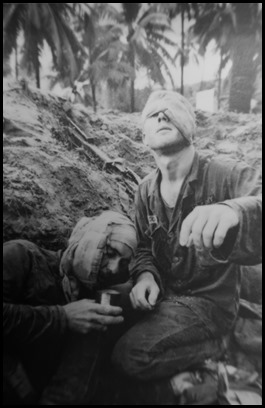 Henri Huet, Chu Lai, Vietnam,
1965. U.S. Marine Corps chaplain John Monamara of Boston, Mass., administers the
last rites to dying war-correspondent Dickey Chapelle. She died in the
helicopter on the way to hospital. (Associated Press)
Henri Huet, An Thi, Vietnam, 1966. Wounded and
weary Americans lie in the grit of a sandy ditch during an airstrike on North
Vietnamese positions nearby. Two companies of the First Air Cavalry Division and
Viet Cong – North Vietnamese force had battled for over 24 hours across paddies
and coastal villages (Associated Press)
A medic – calm and dedicated. (Pictures by
photographer Henri Huet appeared in many newspapers around the world and in LIFE
magazine of February 11, 1966 and have become part of an unforgettable sequence
of one man’s dedication).
Although his own wound was so
completely bandaged that he could barely peer out of one eye, Private First
Class Thomas Cole, a young medic of the 1st Cavalry Division, spent hours
tending fellow soldiers worse off than he. One was Staff Sergeant Harrison Pell,
whose bandaged head Cole cradled on his knee and fed C-rations to him, then
carefully wiped his face.
Cole’s luck ran out on June 20,
1966 after he had taken part in every major battle the 1st Cavalry had been in
since arriving in Vietnam. He was severely wounded while on operation near the
hamlet of Dong Tre, 255 miles north of Sai Gon. (From Associated Press newswire
reports)
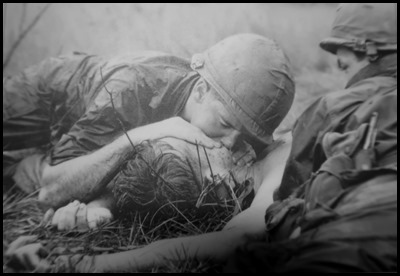  Henri Huet, War Zone D, Vietnam, 1967.
Specialist 4 James E. Callahan applied mouth-to-mouth resuscitation in an effort
to keep the soldier alive. The effort failed. (Associated
Press)
Henri Huet, War Zone D, Vietnam, 1967.
Specialist 4 James E. Callahan, a medic from Pittsfield, Massachusetts, ducks
sniper fire to tend the wounds of an infantryman with a serious headwound during
an ambush near Sai Gon. (Associated Press)
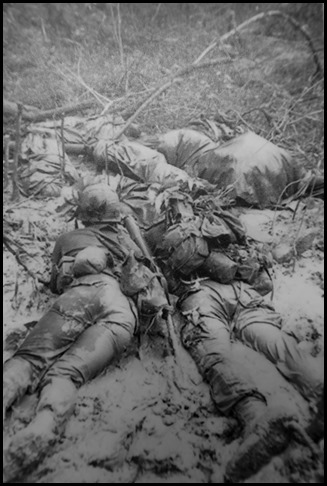  Henri Huet, War Zone D, Vietnam, 1967.
Half-submerged in slimy mud two infantrymen crawl forward firing and take cover
behind the poncho-wrapped bodies of three dead soldiers. They fought in dense
jungle between muddy bomb craters (AP)
Henri Huet.
Bernard B. Fall in Vietnam, 1967. (Associated Press) Bernard B. Fall, France,
Born: November 19, 1926, in Vienna, Austria. Died: February 21, 1967, on the
‘Street without Joy’, northwest of Hue. Bernard B. Fall was photographed by
Henri Huet in Vietnam, 1967. Henri Huet died in
1971.
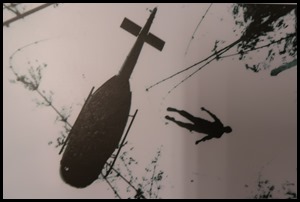  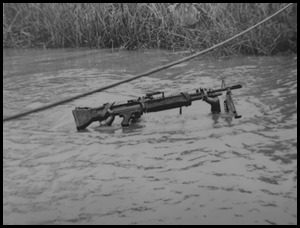 Henri Huet, War Zone C, Vietnam, 1966.
Silhouette of death:the body of an American paratrooper killed in action in the
jungle near the Cambodian border is lifted up to an evacuation helicopter.
(Associated Press)
Henri Huet, near Sai Gon, Vietnam, 1968. Bomb
craters from B-52 strikes mark the rice paddies and orchards west of Sai Gon.
Most of the area had been abandoned by the peasants who used to farm them
(Associated Press)
Henri Huet, Mekong delta, 1968. A rope keeps a
U.S. machine-gunner from going under as he crosses a muddy stream. (Associated
Press)
 Sergio Or Tiz,
Ham Nghi, Vietnam, 1971. The last picture of photographers Larry Burrows (Life
Magazine), center, Henri Huet (Associated Press), left, Kent Potter (United
Press International), right, and Keisaburo Shimamoto (Newsweek), background,
boarding their helicopter before it crashed in Laos on February 10, 1971.
(USMC/AP).
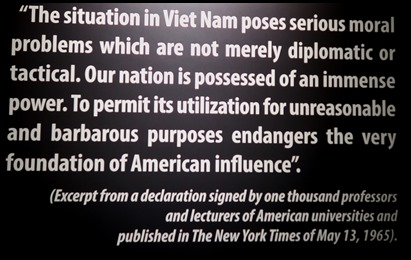 The next three pictures posed a question for us......The
song tells us “the average age of the soldiers in Viet Nam was 19”. Had the
soldiers all been in their forties would these events and many like it have
happened – or do we all get battle weary, desensitised, gain a ‘kill or be
killed’ mentality, or simply not give a damn ???
 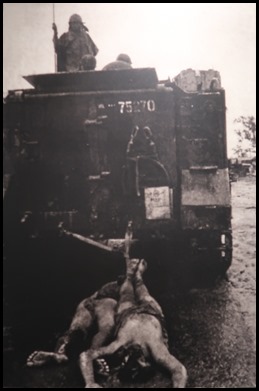 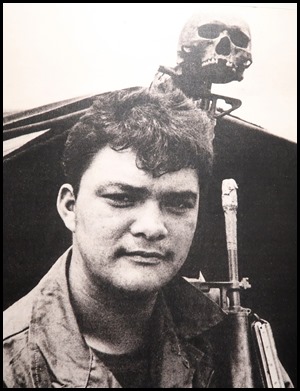 A GI from the 25th Infantry
Division, holding a part of a corpse of a Liberation soldier killed by a grenade
launcher. Tay Ninh Province. 1967. Photo: Ishikawa Bunyo. GI’s tie up prisoners
to their tank and drag them to death. An American soldier with the skull of a
Vietnamese patriot.
We couldn’t leave this exhibition
without taking a moment or two in front of the very iconic
image.
 On June 6 1972, US troops dropped
napalm bombs down to Trang Bang district, Tay Ninh province, destroying houses,
farms and civilians. This attack also caused a 9-year-old girl named Phan Thi
Kim Phuc to get burned desperately.
The photo of “Napalm Girl” taken
by reporter Huynh Cong Ut (Nick Ut) received a number of international awards,
including World Press Photo (the largest European press photography award) and
Pulitzer Prize (an academy press award) in 1972. This photo was ranked 41 over
100 most influential photos of the 20th century voted by Columbia
University.
On March 29, 2013, Nick Ut
presented this photo to War Remnants Museum.
ALL IN ALL FACTUAL, MOVING –
AS IT SHOULD BE
QUITE
REMARKABLE |
